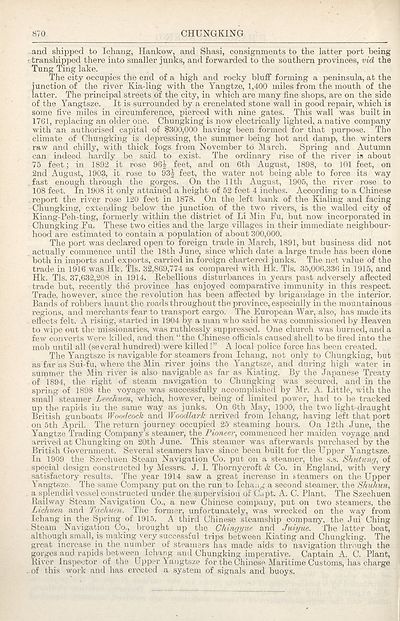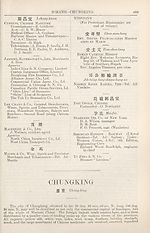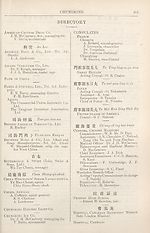1918
(946) Page 870
Download files
Complete book:
Individual page:
Thumbnail gallery: Grid view | List view

870
CHUNGKING
and shipped to Ichang, Hankow, and Shasi, consignments to the latter port being
> transhipped there into smaller junks, and forwarded to the southern provinces, vid the
Tung Ting lake.
The city occupies the end of a high and rocky bluff forming a peninsula, at the
junction of the river Kia-ling with the Yangtze, 1,400 miles from the mouth of the
latter. The principal streets of the city, in which are many fine shops, are on the side
of the Yangtsze. It is surrounded by a crenelated stone wall in good repair, which is
some five miles in circumference, pierced with nine gates. This wall was built in
1761, replacing an older one. Chungking is now electrically lighted, a native company
with an authorised capital of $300,000 having been formed for that purpose. The
climate of Chungking is depressing, the summer being hot and damp, the winters
raw and chilly, with thick fogs from November to March. Spring and Autumn
can indeed hardly be said to exist. The ordinary rise of the river is about
75 feet; in 1892 it rose feet, and on 6th August, 1898, to 101 feet, on
2nd August, 1903, it rose to 93^ feet, the water not being able to force its way
. fast enough through the gorges. On the 11th August, 1905, the river rose to
108 feet. In 1908 it only attained a height of 52 feet 4 inches. According to a Chinese
report the river rose 120 feet in 1878. On the left bank of the Kialing and facing
Chungking, extending below the junction of the two rivers, is the walled city of
Kiang-Peh-ting, formerly within the district of Li Min Fu, but now incorporated in
Chungking Fu. These two cities and the large villages in their immediate neighbour¬
hood are estimated to contain a population of about 300,000.
The port was declared open to foreign trade in March, 1891, but business did not
actually commence until the 18th June, since which date a large trade has been done
both in imports and exports, carried in foreign chartered junks. The net value of the
trade in 1916 was Hk. Tls. 32,869,774 as compared with Hk. Tls. 35,006,336 in 1915, and
Hk. Tls. 37,632,208 in 1914. Rebellious disturbances in years past adversely affected
trade but, recently the province has enjoyed comparative immunity in this respect.
Trade, however, since the revolution has been affected by brigandage in the interior.
Bands of robbers haunt the roads throughout the province, especially in the mountainous
regions, and merchants fear to transport cargo. The European War, also, has made its
. effects felt. A rising, started in 1904 by a man who said he was commissioned by Heaven
to wipe out the missionaries, was ruthlessly suppressed. One church was burned, and a
few converts were killed, and then “the Chinese officials caused shell to be fired into the
mob until all (several hundred) were killed!” A local police force has been created.
The Yangtsze is navigable for steamers from Ichang, not only to Chungking, but
as far as Sui-fu, where the Min river joins the Yangtsze, and during high water in
summer the Min river is also navigable as far as Kiating. By the Japanese Treaty
of 1894, the right of steam navigation to Chungking was secured, and in the
spring of 1898 the voyage was successfully accomplished by Mr. A. Little, with the
small steamer Leechiien, which, however, being of limited power, had to be tracked
up the rapids in the same way as junks. On 6th May, 1900, the two light-draught
British gunboats Woodcock and Woodlark arrived from Ichang, having left that port
. on 5th April. The return journey occupied 25 steaming hours. On 12th June, the
Yangtze Trading Company’s steamer, the Pioneer, commenced her maiden voyage and
arrived at Chungking on 20th June. This steamer was afterwards purchased oy the
British Government. Several steamers have since been built for the Upper Yangtsze.
In 1909 the Szechuen Steam Navigation Co. put on a steamer, the s.s. Shutung, of
. special design constructed by Messrs. J. I. Thornycroft & Co. in England, with very
satisfactory results. The year 1914 saw a great increase in steamers on the Upper
Yangtsze. The same Company put on the run to Ichang a second steamer, the Shuhun,
. a splendid vessel constructed under the supervision of CLpt. A. C. Plant. The Szechuen
Railway Steam Navigation Co., a new Chinese company, put on two steamers, the
Lichuen and Tachuen. The former, unfortunately, was wrecked on the way from
Ichang in the Spring of 1915. A third Chinese steamship company, the Jui Ching
, Steam Navigation Co., brought up the Chingyue and Juiyue. The latter boat,
although small, is making very successful trips between Kiating and Chungking. The
great increase in the number of steamers has made aids to navigation through the
gorges and rapids between Ichang and Chungking imperative. Captain A. C. Plant,
River Inspector of the Upper Yangtsze for the Chinese. Maritime Customs, has charge
. of this work and has erected a system of signals and buoys.
CHUNGKING
and shipped to Ichang, Hankow, and Shasi, consignments to the latter port being
> transhipped there into smaller junks, and forwarded to the southern provinces, vid the
Tung Ting lake.
The city occupies the end of a high and rocky bluff forming a peninsula, at the
junction of the river Kia-ling with the Yangtze, 1,400 miles from the mouth of the
latter. The principal streets of the city, in which are many fine shops, are on the side
of the Yangtsze. It is surrounded by a crenelated stone wall in good repair, which is
some five miles in circumference, pierced with nine gates. This wall was built in
1761, replacing an older one. Chungking is now electrically lighted, a native company
with an authorised capital of $300,000 having been formed for that purpose. The
climate of Chungking is depressing, the summer being hot and damp, the winters
raw and chilly, with thick fogs from November to March. Spring and Autumn
can indeed hardly be said to exist. The ordinary rise of the river is about
75 feet; in 1892 it rose feet, and on 6th August, 1898, to 101 feet, on
2nd August, 1903, it rose to 93^ feet, the water not being able to force its way
. fast enough through the gorges. On the 11th August, 1905, the river rose to
108 feet. In 1908 it only attained a height of 52 feet 4 inches. According to a Chinese
report the river rose 120 feet in 1878. On the left bank of the Kialing and facing
Chungking, extending below the junction of the two rivers, is the walled city of
Kiang-Peh-ting, formerly within the district of Li Min Fu, but now incorporated in
Chungking Fu. These two cities and the large villages in their immediate neighbour¬
hood are estimated to contain a population of about 300,000.
The port was declared open to foreign trade in March, 1891, but business did not
actually commence until the 18th June, since which date a large trade has been done
both in imports and exports, carried in foreign chartered junks. The net value of the
trade in 1916 was Hk. Tls. 32,869,774 as compared with Hk. Tls. 35,006,336 in 1915, and
Hk. Tls. 37,632,208 in 1914. Rebellious disturbances in years past adversely affected
trade but, recently the province has enjoyed comparative immunity in this respect.
Trade, however, since the revolution has been affected by brigandage in the interior.
Bands of robbers haunt the roads throughout the province, especially in the mountainous
regions, and merchants fear to transport cargo. The European War, also, has made its
. effects felt. A rising, started in 1904 by a man who said he was commissioned by Heaven
to wipe out the missionaries, was ruthlessly suppressed. One church was burned, and a
few converts were killed, and then “the Chinese officials caused shell to be fired into the
mob until all (several hundred) were killed!” A local police force has been created.
The Yangtsze is navigable for steamers from Ichang, not only to Chungking, but
as far as Sui-fu, where the Min river joins the Yangtsze, and during high water in
summer the Min river is also navigable as far as Kiating. By the Japanese Treaty
of 1894, the right of steam navigation to Chungking was secured, and in the
spring of 1898 the voyage was successfully accomplished by Mr. A. Little, with the
small steamer Leechiien, which, however, being of limited power, had to be tracked
up the rapids in the same way as junks. On 6th May, 1900, the two light-draught
British gunboats Woodcock and Woodlark arrived from Ichang, having left that port
. on 5th April. The return journey occupied 25 steaming hours. On 12th June, the
Yangtze Trading Company’s steamer, the Pioneer, commenced her maiden voyage and
arrived at Chungking on 20th June. This steamer was afterwards purchased oy the
British Government. Several steamers have since been built for the Upper Yangtsze.
In 1909 the Szechuen Steam Navigation Co. put on a steamer, the s.s. Shutung, of
. special design constructed by Messrs. J. I. Thornycroft & Co. in England, with very
satisfactory results. The year 1914 saw a great increase in steamers on the Upper
Yangtsze. The same Company put on the run to Ichang a second steamer, the Shuhun,
. a splendid vessel constructed under the supervision of CLpt. A. C. Plant. The Szechuen
Railway Steam Navigation Co., a new Chinese company, put on two steamers, the
Lichuen and Tachuen. The former, unfortunately, was wrecked on the way from
Ichang in the Spring of 1915. A third Chinese steamship company, the Jui Ching
, Steam Navigation Co., brought up the Chingyue and Juiyue. The latter boat,
although small, is making very successful trips between Kiating and Chungking. The
great increase in the number of steamers has made aids to navigation through the
gorges and rapids between Ichang and Chungking imperative. Captain A. C. Plant,
River Inspector of the Upper Yangtsze for the Chinese. Maritime Customs, has charge
. of this work and has erected a system of signals and buoys.
Set display mode to:
![]() Universal Viewer |
Universal Viewer | ![]() Mirador |
Large image | Transcription
Mirador |
Large image | Transcription
Images and transcriptions on this page, including medium image downloads, may be used under the Creative Commons Attribution 4.0 International Licence unless otherwise stated. ![]()
| Asian directories and chronicles > 1918 > (946) Page 870 |
|---|
| Permanent URL | https://digital.nls.uk/194905628 |
|---|
| Attribution and copyright: |
|
|---|---|
| Description | Volumes from the Asian 'Directory and Chronicle' series covering 1917-1941, but missing 1919 and 1923. Compiled annually from a multiplicity of local sources and research. They provide listings of each country's active corporations, foreign residents and government agencies of all nationalities for that year, together with their addresses. Content includes: various treaties; coverage of conflicts; currencies and taxes; consular fees; weights and measures; public holidays; festivals and traditions. A source of information for both Western states and communities of foreigners living in Asia. Published by Hongkong Daily Press. |
|---|---|
| Shelfmark | H3.86.1303 |
| Additional NLS resources: |

